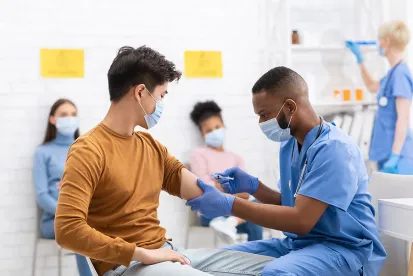On September 24, 2021, the Safer Federal Workforce Task Force (“Task Force”) issued written Guidance to implement Executive Order 14042 (“Ensuring Adequate COVID Safety Protocols for Federal Contractors”), which was signed by President Biden on September 9, 2021. The Guidance is a key component of President Biden’s larger “Path Out of the Pandemic: COVID-19 Action Plan.”
The Task Force is led in combination by the i) White House COVID-19 Response Team, ii) General Services Administration (GSA), and iii) Office of Personnel Management (OPM). Task Force members include: the Centers for Disease Control and Prevention (CDC), the Department of Veterans Affairs (VA), the Federal Emergency Management Agency (FEMA), the Federal Protective Service (FPS), the Office of Management and Budget (OMB), and the United States Secret Service (USSS).
The Guidance requires thousands of businesses to verify that their employees have been vaccinated against COVID-19. It also imposes masking and social distancing requirements. The Guidance is intended to decrease the spread of SARS-CoV-2 (the virus that causes COVID-19), with the ancillary goals of decreasing worker absences, reducing labor costs, and improving the efficiency of those who work for the Federal Government.
The Guidance applies in addition to any OSHA standard, not in the alternative. It also supersedes any conflicting state or local laws. However, the Guidance does not excuse noncompliance with any state or local law that may be more protective of workplace safety.
Below are the essentials that businesses need to know about the new Guidance.
What Businesses and Contracts are Covered?
The Order and Guidance apply to companies with a Federal Government contract or “contract-like instrument” of $250,000 or more (the simple acquisition threshold) (a “covered contract”). Contractors and subcontractors of all tiers are covered (collectively, “covered contractors”), unless the contract or subcontract is solely for the manufacture or provision of products. Contracts for services and leaseholds are covered, and there is no small business exception.
The Guidance applies to new contracts awarded on or after November 14, 2021. For contracts already in existence on October 15, 2021, where performance is ongoing, the requirements must be incorporated when an extension is made or an option is exercised. Between October 15 and November 14, Federal agencies are required to include the clause in the solicitation; they are encouraged to include the clause in contracts, but need not do so unless the solicitation for the contract was issued on or after October 15.
Prime contractors must “flow down” the requirements to first-tier subcontractors. Higher-tier subcontractors must do the same for lower-tier subcontractors, until the requirements are solely for the provision of products.
In addition to contracts that are expressly covered by the Guidance, agencies are “strongly encouraged” to require compliance in non-covered contracts as well, such as those under the simple acquisition threshold, or for the manufacture of products. Agencies are similarly “strongly encouraged” to attempt to incorporate the Guidance into existing contracts and contract-like instruments that pre-date mandatory inclusion of the clause. And, covered contractors are “strongly encouraged” to include similar requirements in agreements with non-covered companies who work at their sites, such as those who provide food services, onsite security, or grounds keeping.
Key Definitions
“Covered contractor workplace”: a location controlled by a covered contractor or subcontractor at which any employee working on or in connection with a covered contract is likely to be present during the performance of a covered contract.
-
This includes workplace locations that are outdoors.
-
Employee residences are not considered covered workplaces.
-
A workplace is deemed to cover an entire building, site, facility, or campus, unless the contract can “affirmatively determine” that no employees on a particular floor, or in a separate area, or in a distinct building, will come into contact with any covered employee. This includes ensuring there will be no interactions of any kind, including in common areas like lobbies, security clearance areas, elevators, stairwells, meeting and conference rooms, kitchens, dining rooms, and parking garages.
-
The Guidance that applies to a “covered contractor workplace” is the same as that for Federal workplaces (those where a Federal executive department or agency conducts official business, or which are under its jurisdiction, custody, or control).
“Covered contractor employee”: any full-time or part-time employee who:
-
Works directly on a covered contract;
-
Works “in connection with” a covered contract. This means people whose duties are “necessary” to the performance of the contract, but who are not directly engaged in the specific work called for in the contract. Examples include human resources, billing, and legal review; OR
-
Works at a covered contractor workplace, even if the employee is not him/herself working on, or in connection with, a covered contract.
Notably, this definition encompasses “employees of covered contractors who are not themselves working on or in connection with a covered contract.” Guidance p. 4 (emphasis added).
The Guidance does not cover employees who only perform work outside the United States.
“Fully vaccinated”: A person is considered “fully vaccinated” two weeks after they have received either a single-dose vaccine or the second dose in a two-dose series. There is currently no post-vaccination time limit on fully vaccinated status (i.e., no time at which vaccination status expires).
To qualify, a vaccine must be either:
-
currently approved, or authorized for emergency use, by the U.S. Food and Drug Administration (“FDA”) – such as Pfizer-BioNTech, Moderna, and Johnson & Johnson/Janssen;
-
authorized for emergency use by the World Health Organization (“WHO”) – such as AstraZeneca/Oxford; or
-
a completed, full series of an active COVID-19 vaccine candidate, administered through a clinical trial, whose efficacy has been independently confirmed by a data and safety monitoring board – such as Novavax.
The Vaccine Mandate
Employers are not required to provide onsite vaccinations to employees. However, covered contractors must do the following:
-
Ensure that all employees are fully vaccinated no later than December 8, 2021 (except those entitled to accommodation as outlined in (3)).
-
This means, for employees who elect a two-dose vaccine, the vaccination process must start by early November.
-
After December 8th, for newly awarded contracts, or exercised options, or renewed or extended contracts, employees must be vaccinated by the first day of the performance period.
-
-
Review documentation from each covered employee to prove vaccination status.
-
Employees cannot “self-certify” that they have been vaccinated. They must either show or provide documentation of vaccination status.
-
Digital copies of paperwork are acceptable (photos, scanned images, etc.).
-
Acceptable documentation includes a vaccination card, an immunization record, a copy of medical records, or other official documentation that contains sufficient details.
-
If an employee does not have, or loses, the documentation, s/he must obtain a new copy of the record from the vaccination provider or a State or local health department.
-
A recent anti-body test may not be used in lieu of proof of vaccination.
-
-
Assess Requests for Accommodation for Medical and/or Religious Reasons.
-
All covered contractor employees must be vaccinated, unless they are legally entitled to an accommodation.
-
Accommodation may be appropriate due to a disability under the Americans with Disabilities Act, or because of a sincerely held religious belief, practice, or observance, under Title VII.
-
The covered contractor is responsible for assessing requests for accommodation. Agencies also must be involved if they are joint employers of the employees in question.
-
What About Remote Workers?
Remote employees who work on a covered contract from their homes must still be vaccinated. This is consistent with the purpose of the Guidance, which is to reduce the spread of COVID-19. However, while in their residences, employees do not have to comply with other requirements in the Guidance, such as masking and physical distancing.
Limited Emergency Exceptions
The head of a federal agency may approve an exception to the vaccination deadline if there is “an urgent, mission-critical need” to use workers who are not fully vaccinated. Even then, the contractor must ensure employees are fully vaccinated within sixty (60) days of beginning work on a covered contract or at a covered workplace.
Masking and Physical Distancing Requirements
In addition to enforcing the vaccine mandate, covered contractors must:
-
Ensure that ALL individuals – employees and visitors – comply with published CDC guidance for masking and physical distancing at covered workplaces.
-
Pursuant to CDC guidance, in areas of high or substantial community transmission, fully vaccinated people should wear a mask in “public indoor settings.” (The EO guidance removes the word “public” and requires that in areas of high or substantial community transmission, fully vaccinated people must wear masks while indoors.)
-
Fully vaccinated people do not currently need to physically distance, regardless of the level of transmission in the area.
-
Persons who are not fully vaccinated must (i) wear a mask indoors, (ii) wear a mask outdoors at crowded settings or at those with sustained close contact of others who are not fully vaccinated, and (iii) maintain a distance of at least six (6) feet from others at all times.
-
-
Ensure that masking is done appropriately when required.
-
Masks must be consistent with CDC recommendations. The following do not qualify: masks with vents/valves/openings; face shields only without a mask; single-layer or thin fabric masks (they should be light-blocking).
-
Masks must be worn consistently and correctly (over mouth and nose). They may be lowered briefly for identification purposes if needed.
-
-
Check the CDC COVID-19 Data Tracker County View website at least weekly in all areas where they have a covered contractor workplace.
-
The employer uses this community transmission information to determine proper workplace safety protocols.
-
When the level of transmission increases from low or moderate, to substantial or high, companies should put the more protective protocols into place.
-
When the level of transmission is reduced, from high or substantial, to moderate or low, transmissions must remain at the lower level for at least two (2) consecutive weeks, before protocols may be changed.
-
-
Assess and, where appropriate, grant, requests for accommodation related to masking.
-
As with the vaccine mandate, some people may be legally entitled to accommodation of a masking requirement, for either medical or religious reasons.
-
Designation of Coordinator
Covered contractors must identify one or more persons who will be charged with coordinating the implementation of, and compliance with, the Guidance. These may be the same person(s) responsible for other COVID-19 workplace safety protocols, such as those required by other local, State, or Federal law. The coordinators are responsible for:
-
ensuring that all employees and other individuals (visitors, contractors, etc.) receive appropriate notice of applicable protocols, whether by email, website, memo, flyers, signage, or other means.
-
ensuring that all proper vaccination documentation has been shown or provided.
Updates to Guidance
The Task Force may update the Guidance to add or change requirements as the pandemic evolves. Covered contractors are required to comply with all Task Force Guidance approved by the OMB Director, for the duration of a covered contract.






 />i
/>i

